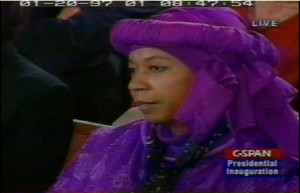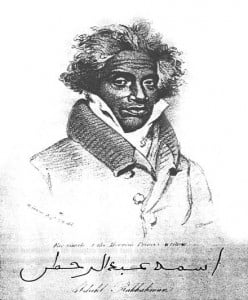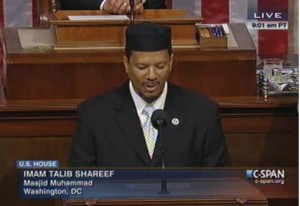Muslim History Detective’s log, 2/28/14

Just four or five rows behind President Bill Clinton and First Lady Hillary Clinton, the Muslim woman sat, adorned in a majestically wrapped and hued purple headdress. The color crowned her glowing brown skin, completing her worthily.
I had not been looking for her. I did not even know she was there. But in that moment she was all that I saw: A dignified pioneer. A familiar face. Sister Amatullah Sharif is her name.
I came across this find a few years ago during one of my Muslim History Detective digs through C-SPAN’s archives.
But I could have found her many places, and much earlier, if only I had been looking for her. I have wanted to write about her ever since.
If we go back and look through the photos and videos of several major milestones for the American Muslim community, we will likely find Sister Amatullah there, off in the distance–recording, facilitating, managing, initiating, always contributing in some significant way.
The Pentagon, the U.S. Capitol, the Department of State, or, on this day, at the 1997 Inaugural Interfaith Prayer Service, broadcast live on television, these are but a few shining examples of where her work took her.
Among the successful efforts she personally initiated include the drive to change Washington, D.C.’s “4th Street” to “Islamic Way” and securing an opportunity for a Muslim to give an invocation on the floor of the United States Senate for the first time in our nation’s history!
And yet, many of you have probably never heard of her.
This reminds me of something my mother once said to me.
She accused me of always telling my father’s story but never telling her story, or asking about her story.
I was guilty as charged.
Since then I have often asked my mother to tell me about her life.
Too frequently, we see only the men in our lives as the superheroes, but the women — perhaps because their works are always so ever-present, surrounding us like a steady, calming hum — they just become part of the backdrop of our lives, even when they are in the forefront.
We do not notice their sacrifices until they are gone. In their absence, when it it is too late to get a fuller picture from them, the reality of their contributions become all too blindingly evident.
This March, I am launching an effort to do a better job at recording the history of American Muslim women. It has been something on my heart for a few years now.
Insha’Allah, a more thorough examination of Sister Amatullah’s contributions will be one of the first stories I cover.
Stay tuned!
(NB: I had planned to write a few (three or four) short pieces during Black History Month that would focus on events connected to Muslims of black African descent who have contributed to the American religious and historical landscape in a significant way. This is my third piece and final piece in that series. Thank you for reading and sharing the stories.)














